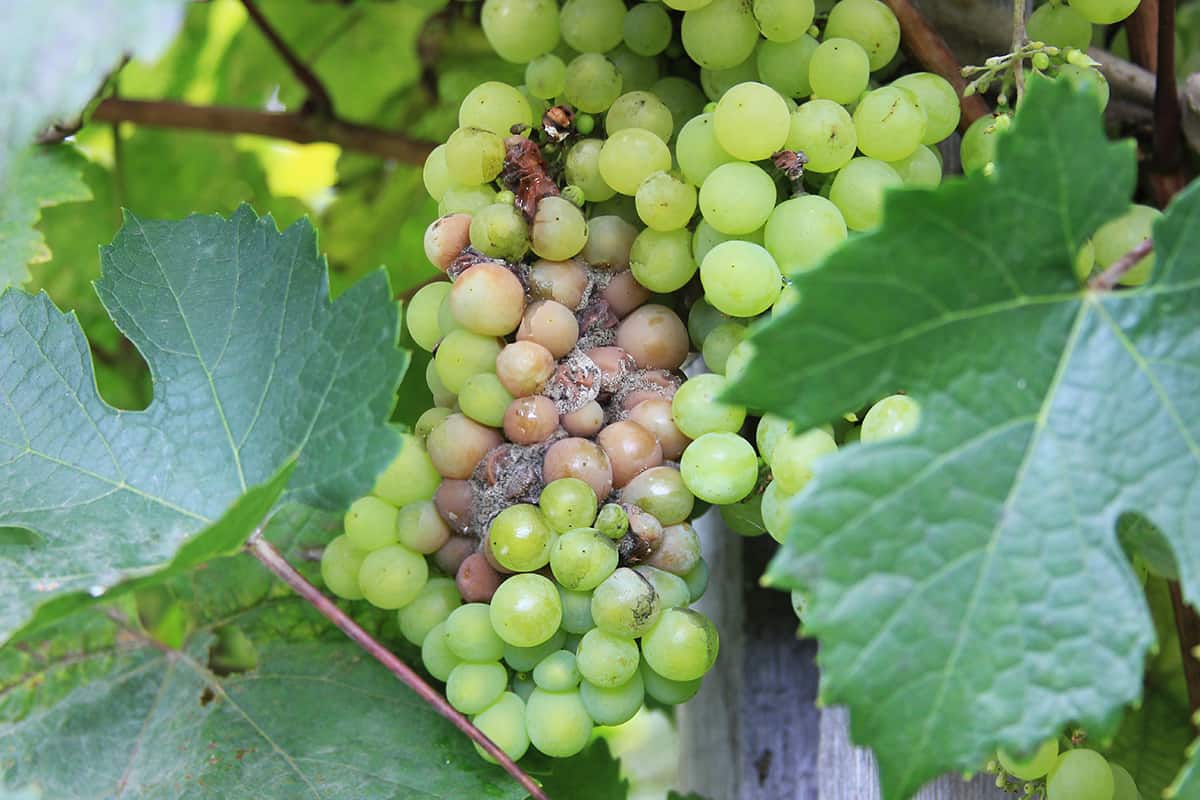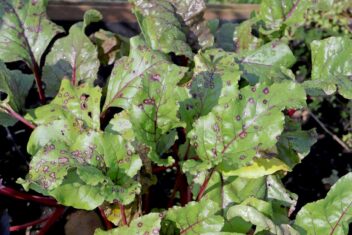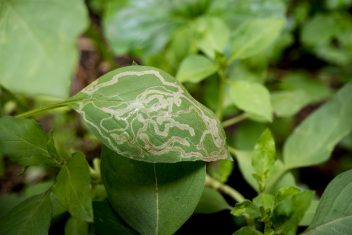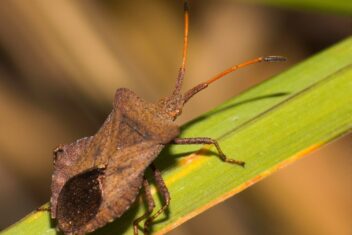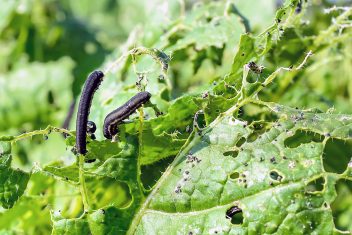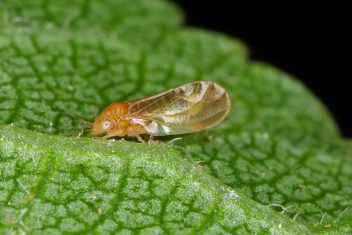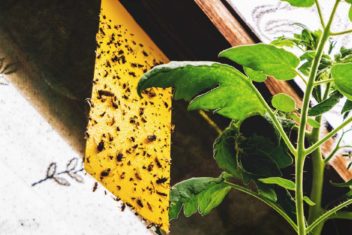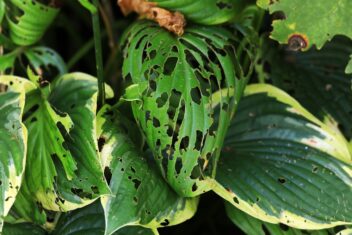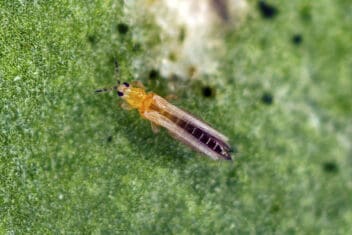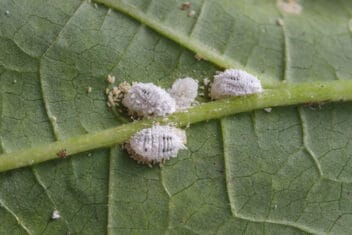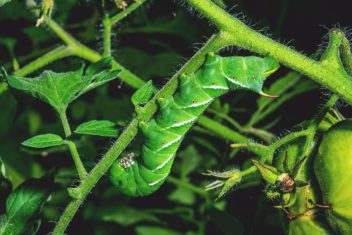People have been growing grapes for centuries. From wineries to table grapes, this indispensable fruit conjures up visions of hillsides planted with old, knurled vines or Romans snacking on them while being fanned with palm fronds. Millions of tons grow each year in the United States alone, and while grapes generally do well in the home garden, they can suffer from pests and diseases.
If you love growing grapes but get annoyed at the sheer number of problems they suffer from, then read on, because this guide can help you out.
Pests of Grapes
There are quite a few pests who like to munch on grapes just as much as we humans do. Here are some of the more common ones you might see.
Japanese Beetles (Popillia japonica)
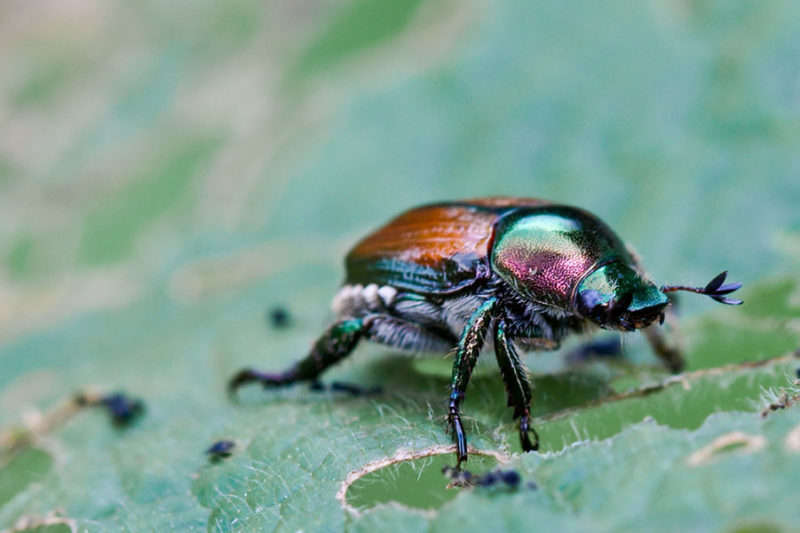
These are small bugs that do big damage. They aren’t picky on what plants they infest, but they have a particular fondness for grapevines. In the midwestern and eastern United States, they are considered a prolific pest.
The most obvious sign of Japanese beetles is skeletonized leaves. This is when the foliage is eaten, and you have just the vein structure left. The beetle is usually hanging around close to the damage or on the soil around the plant, where they drop off the plant when you approach.
They are about 1/2 inch long and have green and blue heads with a tan body and wings. They lay their eggs in the early summer. When the grubs hatch, they remain in the soil for about 10 months, coming out to eat the following summer.
The adults live for just 40 days, but the damage they do in that time is huge. Use row covers, especially in the early months of the growing season when the bugs are busiest. Keep your grapevines healthy by watering and feeding appropriately. This helps your plants withstand an attack.
For more tips, check out our full guide to Japanese beetles.
Black Vine Weevil (Otiorhynchus sulcatus)
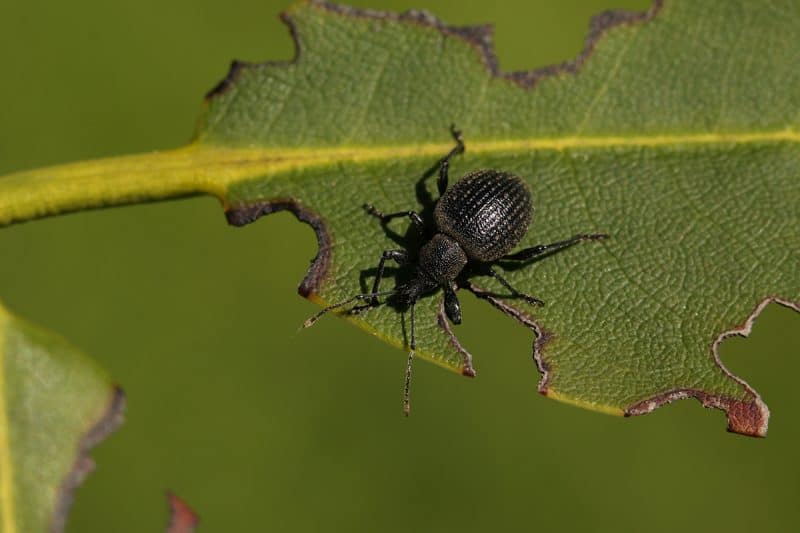
Although not as common in my experience, black vine weevil (aka Taxus weevil) eat all parts of the grape plant from stem up. They will munch on the flowers, buds, leaves, and stems. This causes a loss of vigor and poor fruit growth.
Black vine weevils don’t fly. They have matte black bodies and emerge at night to feed on your plants. They love moist soil and plants to hide in.
Eggs are laid near the crowns of plants. The larvae feed on the roots during winter. They emerge as adults in spring and, within a few weeks, deposit eggs to carry on the cycle.
Keep gardens or the base of grapevines clear of debris and overgrown plants to make your garden less hospitable. You should apply beneficial nematodes in the spring to kill the larvae.
The weevils move along the soil between plants so consider natural remedies like diatomaceous earth to kill them. For a spray option, use a botanical insecticide like pyrethrum or neem oil.
Grape Cane Girdler (Ampeloglypter ater)
Common in central and eastern United States, this bug leaves distinctive evidence of their presence, especially on new grapevines and canes (though damage can appear anywhere). They eat a continuous puncture around the cane, creating a ring. Then, they lay their eggs in these rings or girdles and continue to eat until the cane breaks off at the ring.
The adults are a shiny black beetle about 1/8th of an inch in length, while the larvae are tiny white worms.
Prune the infected canes as soon as you see the damage. The most effective remedy is breaking their cycle with summer pruning. These pests prefer Virginia creeper (Parthenocissus quinquefolia), so you can plant that vine as a trap crop, if you desire.
Grape Mealybug (Pseudococcus maritimus)
This is my most annoying pest of grapes because they cause the secondary issue of sooty mold through the excretion of sticky honeydew, which attracts the mold. The damage is to the fruit as well as the vines and leaves. If your grapes are near pear or apple trees, odds are the grape mealybug will make its way to those as well.
In high numbers, the damage to the fruit on grapevines can be extensive. They’re dormant under the bark of young, lower canes, so often the first sign for home gardeners is the sooty mold. It’s most obvious on the bark of canes and looks dark and wet, like wet fireplace soot.
Encourage or introduce beneficial insects and use pheromone traps if available in your area. For long-term control, use neem oil or insecticidal soap, though you must time application carefully. There are some insecticides available that provide a quicker knock-down. Talk to your local garden expert for the ones that work best in your area.
Only apply insecticides when the bugs are young. Once they develop their waxy white coating, insecticides won’t help at all.
Glassy-Winged Sharpshooter (Homalodisca vitripennis)
This is another pest that causes enough damage on its own and introduces diseases, especially Pierce’s disease, which we will look at later.
Signs include dry and shriveled fruit, leaves turning yellow and red at the edges, and often dropping off with the leaf’s stem still attached to the plant.
The most effective control of this pest is with parasitic wasps and other beneficial insects. Spiders, lacewings, praying mantids, and assassin bugs are their mortal enemies. It’s for this reason you should avoid chemical insecticides to try and control glassy-winged sharpshooters.
There are other common pests that are attracted to grapes including:
- Aphids
- Thrips
- Scale
- Mites
- Butterflies
Diseases of Grapes
As if the number of pests that attack grapes wasn’t enough, there are also quite a few diseases that you’ll need to keep an eye out for.
Botrytis Bunch Rot
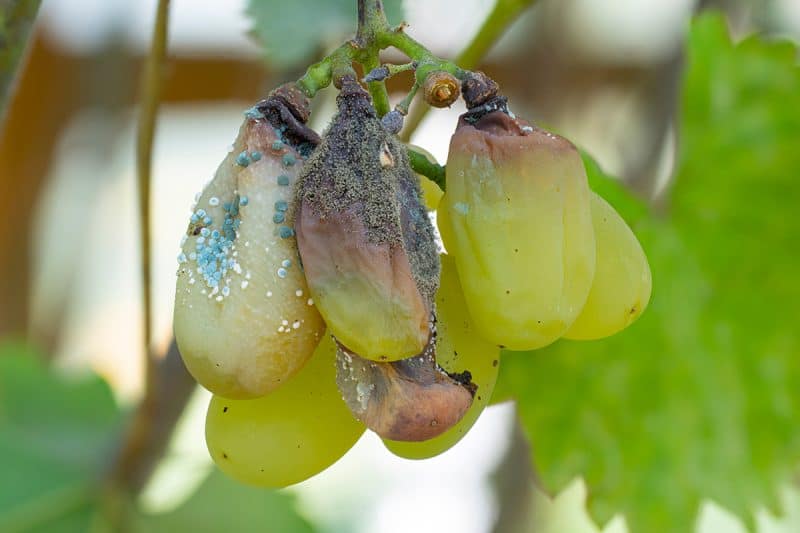
I’ve started with this fungal disease (also known as gray mold) because, for me, it’s the most common issue I face with my grapes most years.
I always know when it will be a problem that year because little tan spots appear on the individual grapes, often when they are still forming. As the grapes mature, they become covered in a white powder, and they shrivel, almost looking like rotten raisins.
To prevent it, reduce the amount of foliage around the grape clusters. This is especially important when humidity is high. That means good, frequent pruning. This disease thrives in cool, wet conditions. Pruning increases sunlight and air circulation.
Also, don’t over-fertilize, which can increase foliage growth, and use a sturdy trellis or similar so that air can flow through the vines. Then, remove any infected leaves right away.
I prefer these methods over chemical remedies because you need to time your spraying around rainfall and humidity, and you must also spray at various times throughout the season. If you get desperate, fungicides are effective if you use them right.
Pierce’s Disease
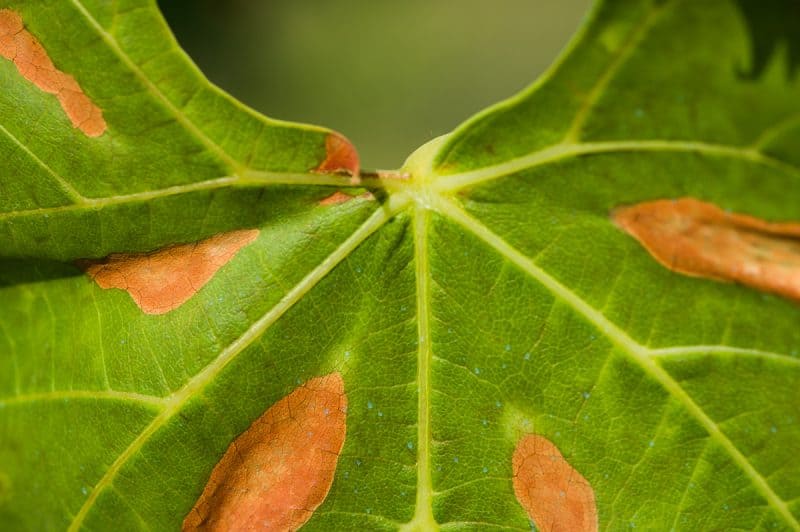
A number of insects (including glassy-winged sharpshooters) spread this bacterial disease. You’ll see leaves turn yellow or red at the edges or centers. They often drop off the vine but leave the little stem end attached.
Controlling insects like glassy-eyed sharpshooters is the best way to prevent this disease. Other insects that spread it are sap suckers like:
- Broadheaded Sharpshooter
- Graphocephala Versuta
- Leafhopper
- Spittlebugs
Young Vine Decline
This is another fungus that isn’t as common as the diseases we’ve already covered, but it’s worth looking at because if the conditions are right, it may make an appearance. Provide plenty of irrigation, especially in dry seasons.
If your vines have it, yellow spots form on the leaves in between the veins, and eventually, they will fall off. The grapes then form lesions, crack and dry up.
This fungal disease often enters the plant through pruning cuts, so use a sealer when trimming. Don’t subject the vines to stress for the first three years. Make sure you give plants plenty of water and the right amount of fertilizer. Be careful not to over-fertilize.
Crown Gall
A gall is an abnormal growth that appears on twigs, branches, and sometimes leaves. They’re unsightly and can harm the plant. With grapes, crown gall causes the leaves to turn yellow, and eventually, the plant collapses.
Since bacteria spread this disease, don’t damage the vine as you work in the surrounding garden. Make sure you sanitize your garden tools before working around your grapes or pruning them.
Die Back
This is a distinctive fungal disease that causes the leaves curl up like a cup and cankers form on some wood of the canes and trunk. The good news is dieback only affects vines that are around six years old or older. That means your new, tender vines have time to grow strong.
To avoid it, apply a pruning sealer when you prune your grapevines. Use a broad-spectrum fungicide, especially if you know others near you have or are suffering from dieback.
Powdery Mildew
This disease seems to get on everything, everywhere. Read our comprehensive article on how to identify, treat and avoid powdery mildew.
Tips to Avoid Grape Pests and Diseases
Of course, the best way to beat these (and all the other) pests and diseases is to do all you can to prevent them in the first place. Here’s what you can do:
- Use dormant sprays. Winter is the time to spray copper and sulfur because many diseases overwinter on your grapevine.
- Prune and destroy any diseased or infected parts immediately.
- Open up the foliage through pruning and let both sun and wind in.
- When you plant new vines, use those naturally resistant to the diseases in your area if they exist.
- If you spray fungicides or pesticides and it rains, respray.
Of course, there are many more pests and diseases that affect grapes, but these are the most likely ones you’ll run up against.
